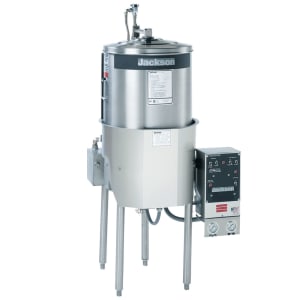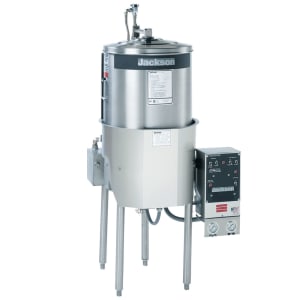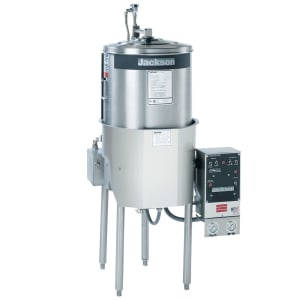Door-Type Dishwashers
Door-type dishwashers are efficient warewashers that help your kitchen run smoothly, even in the face of a Friday-night rush. More

Use 180 degree F water to sanitize and clean completely without chemicals. These may require separate booster heater purchase.

Use chemical sanitizers, providing lower utility and HVAC demand. These will require a contract with a chemical company.
Upright Dishwashers: What You Need to Know
Door-type dishwashers are space-saving alternatives to conveyor-style warewashers, with compact footprints that can be placed in convenient locations. Automated dishmachines come in high-temperature models that sanitize flatware with very hot water and low-temperature models that sanitize with chemical cleansers. Operators will insert racks of dirty dishes – either one or two at a time depending on the model – and the dishwasher will quickly sanitize the dishes and get them ready for reuse.
Door-type dishwashers can manage significantly higher volumes than a standard undercounter dishwasher without reaching the cost or space requirements of a flight-type or conveyor dishwasher. High-efficiency upright dishwashers enable operators to serve customers and lower energy costs, as well as potentially qualifying for ENERGYSTAR® rebates.
Common Questions About Door-type Dishwashers
What is the difference between high- and low-temperature dishwashers?
Health code regulations require automated warewashers utilize either a high-temperature (180 degrees Fahrenheit) sanitization process or a low-temperature chemical sanitization process. The high-temp process kills dangerous bacteria by overheating them – the same way boiling water makes it safe to drink. Low-temp processes use bactericidal chemicals to kill harmful microbes. High-temp units often need a condensation hood to catch the exhaust, which is an additional upfront cost as well as an extra bit of needed space. Many restaurateurs prefer high-temp dishwashers because they don't have the potential to leave distasteful chemical residue on the dishes.
On the other hand, low-temp units don't require as much electricity to run, but they have the continuing cost of chemical cleansers to consider.
What is a hood-type dishwasher?
A hood-type dishwasher has a mechanism that raises the dishwashing compartment up and then lowers it down onto a rack of inserted dishes. This warewasher style is helpful because it doesn't intrude into the working space of the kitchen like a door-type washer, and it's available in both high- and low-temp options. Consider where you'll be placing your dishmachine and the disruption an opening door could cause before choosing between door and hood types.
How is a pot and pan washer different?
Pot and pan washers have strong scrubbing features built in. They're intended to save operators time compared to scrubbing out stubborn pots and pans by hand; however, the high-pressure water used to scrub pots and pans could damage delicate glassware and flatware. Ensure the model you purchase can perform every task you need – including a delicate cycle, if you intend to use one machine as a general dishwasher. If you find your staff spending inordinate amounts of time scrubbing out pots and pans, consider purchasing a dishmachine with this feature.
Do I need a separate utensil washer?
All commercial warewashers should be able to clean utensils as well. Whatever sanitization method you choose, utensils can be cleaned along with the rest of your flatware and dinnerware. Consider a dedicated utensil washer only if you have trouble keeping a suitable supply of utensils available. These are more necessary in fine dining establishments that use multiple pieces of silverware per customer.
How are door-type dishwashers rated?
Warewashers are rated by the number of 20-inch by 20-inch racks they can sanitize per hour. Some models can clean more than one rack at a time, which can save on labor since you won't need an operator standing by to replace the rack every few minutes. Consider how many dishes will fit on each rack and how quickly you need to have the dishes sanitized. Faster machines will typically be more expensive.
Do I need a booster heater for a high-temp dishwasher?
Some high-temp dishwashers come with a built-in temperature booster, while others require a separate purchase. The price of the booster heater will be reflected in the price of a combination unit. Regardless, some sort of power will be needed to raise your water to the 180 degrees Fahrenheit required of high-temperature sanitization. If your water heater can reach 140 degrees Fahrenheit on its own, you only need a 40-degree booster rather than the more powerful 70-degree units. Combined units might take up less space than a washer and booster purchased separately, depending on their design.



